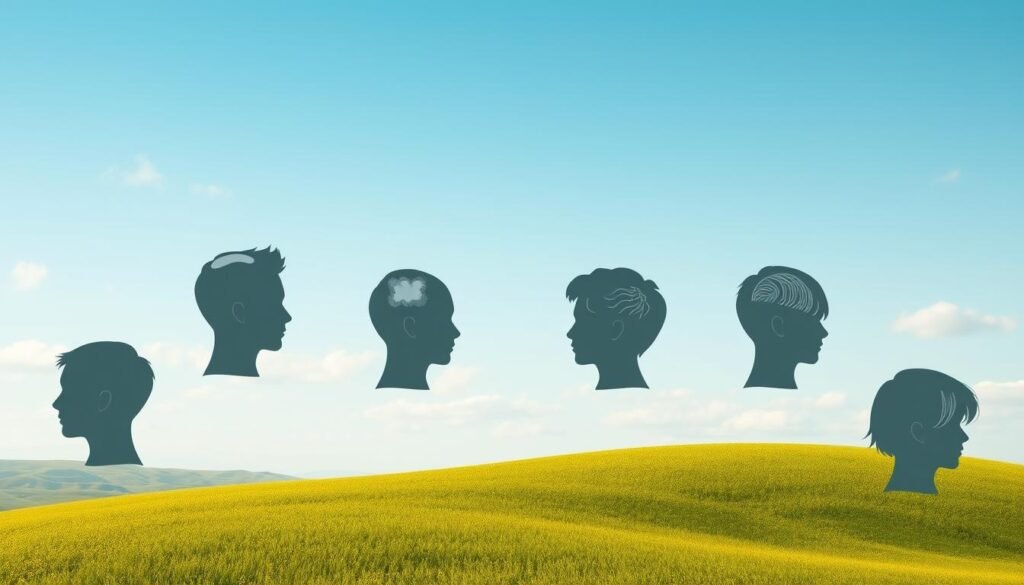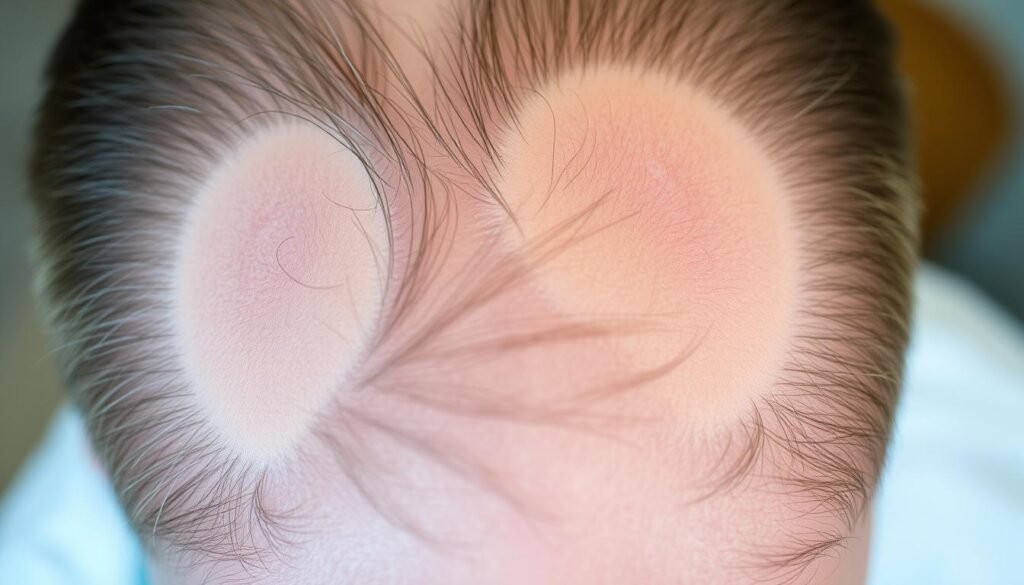Did you know about 50 million men and 30 million women in the U.S. face hair loss? This shows how common alopecia is. It’s a condition that causes hair to fall out. It can really affect how someone looks and feels. Knowing about alopecia is key because it comes in different types.
In this article, we dive into the complex world of hair loss. We’ll look into its different types and see what causes it. By learning about these, you can understand alopecia better. This will help you know what options you have for treating it.
Key Takeaways
- Alopecia affects millions of individuals in the United States.
- Understanding alopecia can aid in addressing its physical and emotional impacts.
- Various types of alopecia exist, each with unique characteristics.
- Genetic and environmental factors play significant roles in hair loss.
- There are multiple treatment options available for managing alopecia.
- Support resources can help individuals cope with the emotional aspects of hair loss.
Understanding Alopecia
Alopecia is a condition where you suddenly lose hair. It can happen to anyone, no matter their age or background. This leads to big emotional and social challenges. The National Alopecia Areata Foundation says about 6.8 million people in the U.S. have this hair loss issue.
Definition and Overview
Alopecia shows up in different ways, each with its own hair loss pattern. It can really affect how people feel about themselves. Many feel alone and not good enough because of how they look. Knowing a lot about Alopecia is key to handling and treating it well.
Prevalence and Impact
Many people experience hair loss, and it can hurt them deeply. More than losing hair, they can feel very anxious or depressed. It’s clear we need places that support these people better. By studying the effects of hair loss, we grow empathy and resources for those in need.
Alopecia Types
Alopecia shows up in various forms. Each has unique traits and possible impacts on people. Knowing the different types helps find the right treatment or management.
Alopecia Areata
Alopecia areata is an autoimmune issue causing sudden, patchy hair loss. It can hit anyone at any age, leading to bald spots on the scalp. The cause is believed to be both genetic and environmental. Catching it early is key to managing it well.
Scarring Alopecia
Scarring alopecia leads to permanent hair loss by damaging hair follicles. It is marked by scar tissue on the scalp. People might feel itching and pain. Treatments aim to lessen inflammation and protect the scalp from more harm.
Male and Female Pattern Hair Loss
Pattern hair loss affects both sexes and is very common. Also called androgenetic alopecia, it’s mainly due to genetics. Men see their hairline move back and thinning atop their heads. Women observe wider hair parting and thinning all over. Knowing about this type is crucial for those looking for solutions or preventive actions.

| Alopecia Type | Characteristics | Population Affected | Treatment Options |
|---|---|---|---|
| Alopecia Areata | Patchy hair loss | All ages | Topical therapies, corticosteroids |
| Scarring Alopecia | Permanent hair loss with scarring | Adults | Anti-inflammatory treatments |
| Male and Female Pattern Hair Loss | Gradual thinning, specific patterns | Both genders | Medications, hair transplant |
Hair Loss Causes
Finding out why hair falls out is key to solving the problem. Both genes and environment matter a lot. They decide how and why someone might lose their hair.
Genetic Factors
Genes have a big impact on hair loss, especially with androgenetic alopecia. If your family has a history of hair loss, you might be more likely to experience it too. Studies show certain genes, like the AR gene, are linked to this condition. Having family members with hair loss means you might have a higher risk yourself. It’s smart to think about your family history when looking at hair health.
Environmental Triggers
There’s more to hair loss than just genetics. Stress, hormone changes, and harmful chemicals can make it worse. How you live, including what you eat and how healthy you are, affects it too. Knowing how these factors work with your genes can help you handle hair loss better. If you’re worried about why you’re losing hair, talking to a doctor might help. For more info, check out this resource.

Autoimmune Alopecia
Autoimmune alopecia is when the body’s defenses wrongly attack healthy hair follicles. This results in hair loss at different levels. The condition can pop up anywhere on the scalp or body without warning. Knowing early signs of alopecia is key to tackle it.
What is Autoimmune Alopecia?
The immune system messes with hair follicles in this condition. People may then see bald spots or thinning hair. Unlike other hair loss types, autoimmune alopecia comes from immune issues.
Symptoms and Diagnosis
Common symptoms of alopecia include:
- Patchy bald spots on the scalp or body
- Excessive shedding of hair
- Complete loss of hair, known as alopecia totalis
Doctors diagnose alopecia with a full check-up, medical history, and sometimes a scalp biopsy. Spotting it early helps in treating it effectively, so knowing the symptoms is crucial.

Alopecia Treatment Options
Alopecia treatments come in different forms. Some are topical, while others are oral medications. Knowing the difference is key to choosing the right path for hair regrowth.
Topical Treatments
Topical treatments target hair loss from the outside. Minoxidil and corticosteroids are popular choices. They work right on the scalp, encouraging hair to grow.
Minoxidil boosts blood flow to the follicles, aiding in hair support. Corticosteroids, on the other hand, lower inflammation and immune issues in alopecia areata.
Oral Medications
Oral medications tackle hair loss from within. Finasteride is effective for male pattern baldness. It slows hair thinning by blocking a testosterone-converting enzyme.
Getting a healthcare provider’s advice is vital. They help tailor the perfect treatment plan for you.
A systematic review points out the need for personalized alopecia treatment. Tailored plans lead to better hair regrowth outcomes, according to the American Journal of Clinical Dermatology.
| Treatment Type | Examples | Application | Notes |
|---|---|---|---|
| Topical Treatments | Minoxidil, Corticosteroids | Applied directly to the scalp | Available OTC and requires consistent use |
| Oral Medications | Finasteride | Taken daily as prescribed | Requires prescription; consult a doctor for advice |
Looking into all alopecia treatment options helps you manage your hair health. For more details on hair loss management, check this useful resource.
Alopecia Management
Managing alopecia includes more than just physical treatments. It also means getting emotional and psychological support. Many people with hair loss feel a mix of emotions. So, effective counseling is key. They can find comfort in talking about their feelings and learning ways to cope.
Counseling and Support
Counseling is vital in handling alopecia. Talking to mental health experts can help people deal with their complex emotions about losing hair. This kind of support is important for staying emotionally strong.
Support groups are also a great help. These meetings can be online or face-to-face. They offer a place to share stories, get advice, and find support from others who understand. This connection is a big part of healing and growing.
Getting the right mix of counseling and group support is key. It helps people feel more confident as they deal with their feelings and experiences.
Hair Regrowth Strategies
Looking into hair regrowth strategies is helpful for people facing hair loss. There are natural and medical ways to boost hair growth. It’s important to know about these options for better hair care decisions.
Natural Remedies
Many natural solutions are touted for hair regrowth. Using essential oils and changing diet are some approaches people try. Here are a few popular natural remedies:
- Rosemary Oil: Known for stimulating the scalp by improving blood flow.
- Biotin Supplementation: Thought to make hair stronger and may help it grow.
- Onion Juice: Some research shows it might help hair grow better.
- Nettle Extract: Full of nutrients, it’s believed to support hair follicle health.
Some people find these remedies work, but the scientific proof is mixed. It’s wise to have realistic hopes.
Medical Treatments
For more serious hair loss, medical options have helped many. Below are some popular choices:
- Platelet-Rich Plasma (PRP) Therapy: Concentrated platelets from your blood are injected into the scalp. It aims to activate hair follicles.
- Hair Transplantation: A process where hair from one area is moved to thinning spots. It’s a long-lasting solution.
- Minoxidil: A topical treatment approved by the FDA to help with baldness.
- Finasteride: Pill form medication for men to halt hair loss and promote growth.
Success with medical treatments varies by person. Talking to doctors is key.
| Strategy | Type | Effectiveness |
|---|---|---|
| Rosemary Oil | Natural Remedy | Moderate evidence |
| PRP Therapy | Medical Treatment | High effectiveness |
| Minoxidil | Medical Treatment | High effectiveness |
| Hair Transplantation | Medical Treatment | Very high effectiveness |
| Biotin | Natural Remedy | Limited evidence |
Coping with Hair Loss
Coping with hair loss brings unique challenges. It impacts emotional health and self-image. Finding emotional support is key to dealing with these issues. Talking with others in the same boat can provide comfort.
Emotional Support
Emotional support comes in many ways. Family and friends offer love and reassurance. Sometimes, talking to a professional helps more with deep issues. A therapist can teach better ways to cope. Accepting yourself is a big step in dealing with hair loss. It helps in moving towards a brighter view of life.
Support Groups and Resources
Being part of support groups is beneficial. These groups, both online and in person, create a welcoming space. Organizations focus on teaching about alopecia. They give useful advice on how to handle it. Sites like Everyday Health and Ageless Glimmer are great for finding help and community.
| Type of Support | Description | Benefits |
|---|---|---|
| Family and Friends | Close relationships can offer reassurance and empathy. | Improved emotional health through understanding. |
| Therapy | Professional support from licensed therapists. | Techniques for managing feelings and self-image. |
| Support Groups | Meetings with others facing similar challenges. | Shared experiences lead to enhanced coping. |
| Online Resources | Websites and forums focused on alopecia. | Access to a wide range of information and community. |
Conclusion
Understanding Alopecia is crucial for anyone facing hair loss. It covers a range of conditions, each with different traits and treatments. Knowing about alopecia helps people deal with hair loss better.
The impact of this condition is not just physical. It affects people emotionally and psychologically too. Making people aware of hair loss is key. It helps create a supportive and understanding community.
There are many treatment options for alopecia. These include creams, pills, or even new therapies. Knowing how thyroid problems or vitamin D affect hair loss is important too. It shows how complex alopecia is. For more information, you can check out comprehensive studies and articles.
Knowledge about alopecia can empower those who have it. It leads to better conversations and support within the community. Understanding alopecia not only helps individuals but also makes society more informed about hair loss.